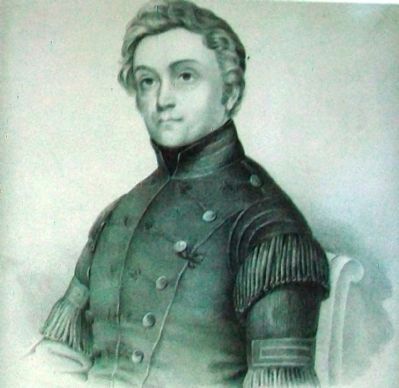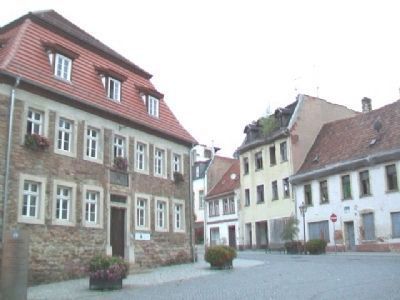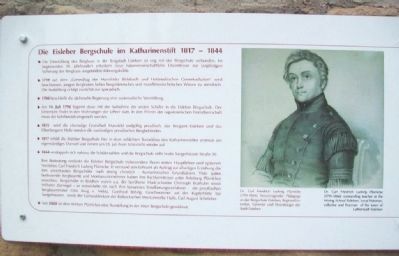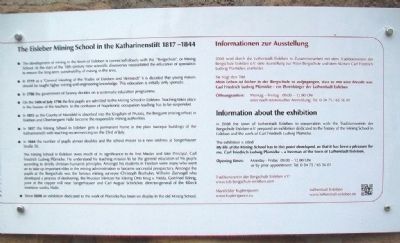Lutherstadt Eisleben in Mansfeld-Südharz, Saxony-Anhalt, Germany — Central Europe
The Eisleber Mining School in the Katharinenstift 1817 - 1844
Die Eisleber Bergschule im Katharinenstift 1817 – 1844
Inscription.
• The development of mining in the town of Eisleben is connected closely with the “Bergschule”, or Mining School. At the start of the 18th century new scientific discoveries necessitated the education of specialists to ensure the long-term sustainability of mining in the area.
• In 1719 at a “General Meeting of the Trades of Eisleben and Hettestedt” it is decided that young miners should be taught higher mining and engineering knowledge. This education is initially only sporadic.
• In 1780 the government of Saxony decides on a systematic education programme.
• On the 14th of July 1798 the first pupils are admitted to the Mining School in Eisleben. Teaching takes place in the houses of the teachers. In the confusion of Napoleonic occupation teaching has to be suspended.
• In 1815 as the County of Mansfeld is absorbed into the Kingdom of Prussia, the Bergamt (mining office) in Eisleben and Oberbergamt Halle become the responsible mining authorities.
• In 1817 the Mining School in Eisleben gets a permanent home in the plain baroque buildings of the Katharinenstift with teaching recommencing on the 23rd of July.
• In 1844 the number of pupils almost doubles and the school moves to a new address at Sangerhäuser Straße 30.
The Mining School in Eisleben owes much of its significance to its first Master and later Principal, Carl Friedrich Ludwig Plümicke. He understood his teaching mission to be the general education of his pupils according to strictly [C]hristian-humanist principles. Amongst his students in Eisleben were many who went on to take up important roles in the mining administration or became successful prospectors. Amongst the pupils at the Bergschule was the famous mining surveyor Christoph Brathuhn, Wilhelm Ziervogel who developed a process of desilvering, the Prussian Minister for Mining Otto Krug v. Nidda, Gottfried Röhrig, juror at the copper mill near Sangerhausen and Carl August Schröcker, director-general of the Ribeck montane works, Halle.
• Since 2008 an exhibition dedicated to the work of Plümicke has been on display in the old Mining School.
[Photo caption reads] Dr. Carl Friedrich Ludwig Plümicke (1791-1866) outstanding teacher at the Mining School Eisleben, Local historian, collector and freeman of the town of Lutherstadt Eisleben.
————————————————
• Die Entwicklung des Berghaus in der Bergstadt Eisleben ist eng mit der Bergschule verbunden. Im beginnenden
18. Jahrhundert erdordern neue naturwissenschaftliche Erkenntnisse zur langfristigen Sicherung des Berghaus ausgebildete Führungskräfte.
• 1719 auf dem „Generaltag der Mansfelder Eislebisch und Hettstedtischen Gewerkschaften” wird beschlossen, jungen Bergleuten hohes bergmännisches und maschinentechnisches Wissen zu vertmitteln. Die Ausbildung erfolgt zunächst nur sporadisch.
• 1780 beschließt die sächsische Regierung eine systematische Vermittlung.
• Am 14. Juli 1798 beginnt diese mit der Aufnahme der ersten Schüler in die Eisleber Bergschule. Der Unterricht findet in den Wohnungen der Lehrer statt. In den Wirren der napoleonischen Fremdherrschaft muss der Lehrbetrieb eingestellt werden.
• 1815 wird die ehemalige Grafschaft Mansfeld endgültig preußisch, das Bergamt Eisleben und das Oberbergamt Halle werden die zuständigen preußischen Bergbehörden.
• 1817 erhält die Eisleber Bergschule hier in dem schlichten Barockbau des Katharinenstiftes erstmals ein eigenständiges Domizil und nimmt am 23. Juli ihren Unterricht wieder auf.
• 1844 verdoppeln sich nahezu die Schülerzahlen und die Bergschule zieht in die Sangerhäuser Straße 30.
Ihre Bedeutung verdankt die Eisleber Bergschule insbesondere ihrem ersten Hauptlehrer und späterem Vorsteher, Carl Fredrich Ludwig
Plümicke. Er verstand sein Lehramt als Auftrag zur allseitigen Erziehung der ihm anvertrauten Bergschüler nach streng christlich – humanistischen Grundsätzen. Viele später bedeutende Bergbeamte und Montanunternehmer haben ihre Fachkenntnisse unter Anleitung Plümickes erworben. Bergschüler in Eisleben waren u.a. der berühmte Mark scheider Christoph Brathuhn sowie Wilhelm Ziervogel – er entwickelte ein nach ihm benanntes Entsilberungsverfahren – die preußischen Bergbauminister Otto Krug v. Nidda, Gottfried Röhrig, Geschworener auf der Kupferhütte bie Sangerhausen, sowie der Generaldirektor der Riebeckschen Montanwerke Halle, Carl August Schröcker.
• Seit 2008 ist dem Wirken Plümickes eine Ausstellung in der Alten Bergschule gewidmet.
[Bildtitel liest] Dr. Carl Friedrich Ludwig Plümicke (1791-1866) hervorragender Pädagoge an der Bergschule Eisleben, Regionalhistoriker, Sammler und Ehrenbürger der Stadt Eisleben.
Topics. This historical marker is listed in these topic lists: Education • Industry & Commerce • Science & Medicine. A significant historical date for this entry is July 14, 1798.
Location. 51° 31.714′ N, 11° 32.549′ E. Marker is in Lutherstadt Eisleben, Sachsen-Anhalt (Saxony-Anhalt), in Mansfeld-Südharz. Marker is on Sangerhäuser Straße just west of Steinweg, on the left when traveling
west. Touch for map. Marker is at or near this postal address: Sangerhäuser Straße 30, Lutherstadt Eisleben ST 06295, Germany. Touch for directions.
Other nearby markers. At least 8 other markers are within walking distance of this marker. Martin Luther Death House (about 150 meters away, measured in a direct line); Altes Gymnasium (about 150 meters away); Martin Luther Quotes (about 180 meters away); Residence of Richard Wagner (about 180 meters away); City Seat of the Counts of Mansfeld-Hinterort (about 180 meters away); a different marker also named Residence of Richard Wagner (approx. 0.3 kilometers away); Martin Luther (approx. 0.3 kilometers away); Markt 54 Birthplace of Alwin Sörgel (approx. 0.3 kilometers away). Touch for a list and map of all markers in Lutherstadt Eisleben.
Regarding The Eisleber Mining School in the Katharinenstift 1817 - 1844. Geschichte der Eisleber Bergschule 1798-1928 : für die Vereinigung ehemaliger Eisleber Bergschüler, a book (in German) by Hans Räck, provides a history of the mining school.
Also see . . . Traditionsverein der Bergschule Eisleben e.V. (Submitted on November 19, 2013, by William Fischer, Jr. of Scranton, Pennsylvania.)
Credits. This page was last revised on January 28, 2022. It was originally submitted on November 19, 2013, by William Fischer, Jr. of Scranton, Pennsylvania. This page has been viewed 663 times since then and 4 times this year. Photos: 1, 2, 3, 4, 5. submitted on November 19, 2013, by William Fischer, Jr. of Scranton, Pennsylvania.




